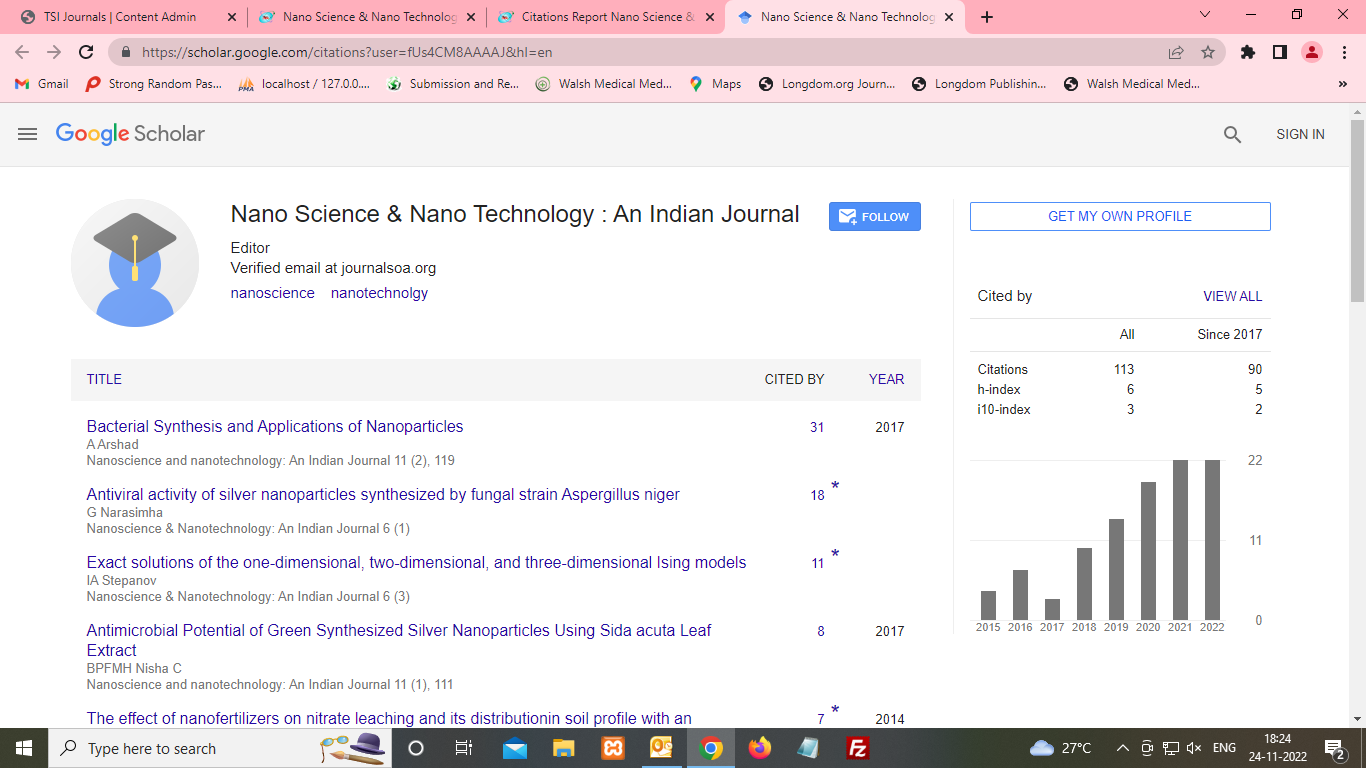Opinion Review
, Volume: 17( 1) DOI: 10.37532/ 0974-7494.2023.17(1).188Nanotechnology in healthcare
- *Correspondence:
- Christopher AdamsEditorial Office, Nanoscience & Nanotechnology: An Indian Journal, UK ; E-mail: adams@nano.com
Received: March 2, 2023, Manuscript No tsnsnt-23-95000; Editor assigned: March 4, 2023, PreQC No. tsnsnt-23-95000 (PQ); Reviewed: March 16, 2023, QC No tsnsnt-23-95000 (Q); Revised: March 19, 2023, Manuscript No tsnsnt-23-95000 (R); Published: March 30, 2023, doi: 10.37532/ 0974-7494.2023.17(1).188
Citation: Adams C. Nanotechnology in Healthcare. Nano Tech Nano Sci Ind J. 2023; 17(1):188.
Abstract
Nanotechnology has the potential to revolutionize medicine by enabling the development of new materials and devices that can be used to diagnose and treat diseases in ways that were previously impossible. One of the most promising applications of nanotechnology in medicine is the development of new drug delivery systems, which could improve the precision and effectiveness of medication. Nanorobots could also be used to diagnose and treat diseases, while nanosensors could detect diseases in their early stages. However, there are concerns about the safety of nanoparticles and more research is needed to ensure their safe use in medicine. Overall, nanotechnology has the potential to greatly improve the health and well-being of people around the world.
Introduction
Nanotechnology has the potential to revolutionize medicine by enabling the development of new materials and devices that can be used to diagnose and treat diseases in ways that were previously impossible. One of the most promising applications of nanotechnology in medicine is the development of new drug delivery systems, which could improve the precision and effectiveness of medication. Nanorobots could also be used to diagnose and treat diseases, while nanosensors could detect diseases in their early stages. However, there are concerns about the safety of nanoparticles and more research is needed to ensure their safe use in medicine. Overall, nanotechnology has the potential to greatly improve the health and well-being of people around the world.
Nanotechnology, the manipulation of matter at the nanoscale level, has the potential to revolutionize medicine in the coming years. With the ability to manipulate matter at such a small scale, researchers can create new materials and devices that can be used to diagnose and treat disease in ways that were previously impossible.
One of the most promising applications of nanotechnology in medicine is the development of new drug delivery systems. Traditional drug delivery methods often result in a large portion of the medication being destroyed by the body before it can reach the targeted area. However, with nanotechnology, researchers can create nanoparticles that can be directed to specific cells or tissues, allowing for more precise drug delivery.
In addition, nanoparticles can be designed to be biocompatible, meaning that they will not be rejected by the body. This is important because many traditional drug delivery systems can cause adverse reactions in patients.
Another potential application of nanotechnology in medicine is in the development of nanorobots. These tiny robots, which would be capable of moving through the body, could be used to diagnose and treat disease in ways that were previously impossible. For example, nanorobots could be used to detect cancer cells in the body and destroy them without harming healthy cells.
There are, however, concerns about the safety of nanotechnology in medicine. Because nanoparticles are so small, they can easily pass through cell membranes and enter cells. This could lead to unintended consequences, such as toxicity or the activation of the immune system. As a result, researchers are carefully studying the safety of nanoparticles in order to minimize potential risks.
Despite these concerns, the potential benefits of nanotechnology in medicine are vast. With continued research and development, nanotechnology could lead to new treatments and diagnostic tools that could greatly improve the health and well-being of people around the world.
Future aspects
Looking ahead, the potential for nanotechnology in medicine is vast. In the future, we can expect to see even more advanced nanoscale materials and devices that can be used for a wide range of medical applications. Here are some potential future aspects of nanotechnology in medicine:
1.Targeted drug delivery: With further development of nanoscale drug delivery systems, drugs could be delivered even more precisely to specific cells and tissues in the body, resulting in more effective treatments with fewer side effects.
2.Nanorobots: As nanotechnology advances, we can expect to see even more sophisticated nanorobots that are capable of carrying out complex tasks, such as repairing damaged tissues or destroying cancer cells.
3.Disease detection and monitoring: Nanosensors could be used to detect diseases in their earliest stages, allowing for earlier intervention and better outcomes for patients. In addition, nanosensors could be used to continuously monitor health and detect any changes that could indicate the presence of disease.
4.Personalized medicine: Nanotechnology could enable the creation of personalized medicines that are tailored to the individual needs of each patient, based on their specific genetic makeup and other factors.
5.Regenerative medicine: By using nanoscale materials and devices, it may be possible to regenerate damaged tissues and organs, leading to new treatments for conditions that are currently untreatable.
Overall, the future of nanotechnology in medicine is exciting and holds great potential for improving the health and well-being of people around the world. Continued research and development in this field will be essential to unlocking the full potential of nanotechnology in medicine.
Conclusion
In conclusion, the field of nanotechnology holds great promise for the advancement of medicine. With the ability to manipulate matter at the nanoscale level, researchers can create new materials and devices that can be used to diagnose and treat disease in more precise and effective ways. From drug delivery systems to nanorobots and nanosensors, nanotechnology has the potential to revolutionize the way we approach medicine. However, it is important to continue to study the safety of nanoparticles in order to minimize any potential risks. With continued research and development, nanotechnology could lead to significant improvements in the health and well-being of people around the world.

